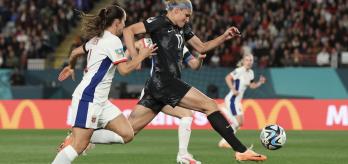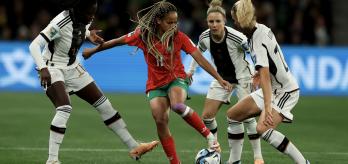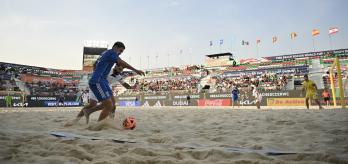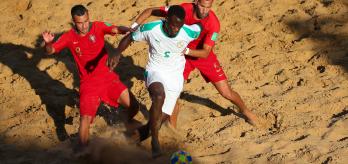New Zealand produced a historic win over Norway in the opening game of the FIFA Women's World Cup Australia & New Zealand 2023™. The co-hosts' victory was their first ever at a FIFA World Cup (despite five previous appearances at the finals), and the three points gained put them in a solid position for their remaining two group fixtures. A combination of tactical shrewdness in targeting the channels behind Norway's full-backs and good organisation out of possession helped the Football Ferns come out on top in what was a closely fought contest.
Key insights
- The way a team attacks is inextricably linked with the way the opposition defends and vice versa. Recognising the connection between two opposing strategies can shed light on an effective game plan.
- If an opponent pushes on to pressure an attacking team, this in turn leaves space the attacking team can exploit. Where this space appears depends on when, where and how an opponent presses.
- If a team defends effectively in a block and prevents the opposition from playing through their lines, this can result in the opposition resorting to long balls. The ability to defend against these types of passes and to secure the first and second ball is therefore an important part of a well-thought-out defensive strategy.
Line-ups
In possession: exploiting space in behind the full-backs
When playing out from the back, New Zealand adopted a 4-4-2. The defining feature of this formation in their game against Norway was arguably the role of the front two, Hannah Wilkinson (17) and Jacqui Hand (16). The movements the two strikers made in behind Norway's full-backs would prove pivotal, with Hand's assist for Wilkinson's winning goal a prime example of their success.
Patient and direct
Yallop was struck by the hosts' approach to possession, which combined patience with a direct playing style. As she explains, "New Zealand were looking to play directly into the wide channels, but if this option wasn't available, they were also happy to keep the ball for a couple more passes and then play directly into Wilkinson" (see Clip 1 below).
The aim of exploiting the spaces created by the opponent's pressing strategy becomes clear in the second video clip. When New Zealand circulated the ball to their wide players, Norway's wide pressing trigger would be activated, meaning the Norwegian full-backs or wingers would push on to actively engage the player in possession. As these defenders moved towards New Zealand's wide players, they created the space for Wilkinson and Hand to target.
A unique goal kick routine
The move leading up to the game's only goal was initiated with a goal kick, something that merits closer analysis (see Clip 3). Instead of goalkeeper Victoria Esson (22) starting the attack, New Zealand caught Norway off guard by having outfield player Katie Bowen take the kick, a set-piece routine that certainly got the attention of FIFA Goalkeeping Expert Pascal Zuberbühler. "This is a fantastic goal kick variation", he said. "It is clear they trained this; nobody expected that the centre-back would take the goal kick and play out on the right side. Everyone expected that the goalkeeper would start the play. If you are the Norway left-back, who is left in a dilemma as her team is out of position, what can you do?"
An effective front two and the development of Wilkinson's game
New Zealand's forwards operated as a pair, with Wilkinson in the Number 9 role and Hand as Number 10. Working together, they provided plenty of options in behind for their team-mates to play into. Yallop felt Wilkinson's success in getting in behind Norway played a key role in New Zealand's narrow victory. "It really highlighted the difference between the two teams", she noted, "because Norway was also trying to play a direct style of football and wasn't as successful. Wilkinson offered in behind and subsequently received the ball 12 times, which is eight more times than the next highest player; this is really reflective of how the game went and what made New Zealand more successful."
Although the way Wilkinson offered to receive the ball in behind made a big difference, her willingness to make herself available between Norway's defensive and midfield lines (which she did 11 times, ranking 2nd in the match) also made a major impact, as Yallop was keen to stress. "Obviously, she looked in behind a lot and was successful in that way, but a really big difference was also how she was able to come off the front and secure the ball for New Zealand when they played directly into her, something she has worked on."
Out of possession: switching between a block and a press
Without the ball, New Zealand's preferred shape was a mid-block, and they spent 18% of their time out of possession in this phase. Their defensive structure was compact, and would have been within the narrowest five percent of defensive shapes at FIFA Women's World Cup 2019™. As Yallop observed, "The compactness and connectivity between the players made it a very cohesive performance and difficult for Norway to play through [the defence]." Starting in this shape, the Football Ferns were able to spot the right moment to start pressing in specific areas of the pitch, something they did to great effect.
Preventing Norway from progressing forward
New Zealand's patience and organisation in the mid-block phase forced Norway's hand. With the passing lanes to their central midfielders closed and opportunities to break lines few and far between, Norway's centre-backs would often resort to playing long balls over the first two lines of New Zealand's defence (see Clip 4 below). The Football Ferns' central midfielders Malia Steinmetz (6) and Ria Percival (2) had an important dual role in these situations. During Norway's deep build-up phase, the midfield duo cut off the passing lanes between Norway's defenders and attacking midfielders. Then, when Norway's defenders resorted to long passes into New Zealand's defensive third, Steinmetz and Percival went after the second ball, claiming 17 and 11 second balls respectively.
Yallop noted that "Norway has a front three consisting of three of the top ten players in the world; you wouldn't have known it by watching this game - they were very limited in possession." Norway's Guro Reiten (11), one of the best wingers in the women's game, had an offer-to-reception rate of 17% (meaning she only received the ball 17% of the times she offered for it). This was by far the lowest figure for any player in the match, again illustrating how New Zealand's organised mid-block denied opportunities for Norway's most dangerous attacking players.
Initiating the press and locking the opponent in
Yallop was also impressed by the way the co-hosts switched effectively from their mid-block into an active press. "New Zealand were patient and picked their moments when to press, and the data indicates how successful they were in doing that,” she said. New Zealand applied pressure 77 times from the middle third and interrupted play a magnificent 28 times. “They weren't just pressing for the sake of pressing. It was very clear that when they chose to go, the whole team went together," said Yallop. "In their 4-4-2 formation, New Zealand would slide across to a targeted side and the strikers would wait for the ball to go into Norway's full-back on that side. Once the full-back receives the ball and decides to recycle it back to their nearest centre-back, the New Zealand striker furthest away from the target side would push up to that Norway centre-back. This would lock in both the centre-back and full-back in the targeted side. Because the Norway full-back and centre-back were unable to play out, it would be a lot easier for the rest of the New Zealand team to press and be aggressive as well" (see Clip 5).
When New Zealand won the ball in these scenarios, their attacking transitions unfolded quickly and targeted the same spaces as they did during their build-up phase. As Yallop points out, "When they win the ball back, they're straight away looking in that channel and Wilkinson is already peeling [away] and making that run. It's obviously something they really practised and were looking forward for, for that pass into the channel behind the opposition full-backs."
Football is a game of two teams
New Zealand versus Norway demonstrated how the way one team defends is inextricably linked with the way the opposition attacks and vice versa. The defining feature of New Zealand's performance – their ability to exploit space behind Norway's full-backs – arose as a result of Norway's decision to use the Football Ferns' wide players receiving the ball as a pressing trigger. The hosts' awareness of Norway's pressing strategy, and their effectiveness in exploiting it, provided them with their most fruitful attacking moments of the match.






















